
 |
|
#1
|
|||
|
|||
|
Or shall I say, hacked?
Anyways, I posted a "N(revoiced)GD" last night because I was so pumped about the results from my shaving experiment. Id like to explain what I did more explicitly and then if love feedback and suggestions as to anything else I can do (ie, any other braces to shave?) I also want to know if this guitar, a stock 6 string, actually has 12 string bracing? Gitnoob brought this up and I'm starting to think it might. Although this a limited dataset, I saw plans from "ultimate guitar plans online" both for the 12 and 6 string jumbo and my guilds bracing matches the 12 string, with 3 tone bars instead of two. So, here's what I did: - I looked at a lot of x-bracing setups and identified the back side X's as one target to remove material and secondly the tone bars. I guess the bracing is tapered but I decided to scallop them out crudely as I figured this was easiest to do without being able to see and having a small hand plane. - I tone tapped the top by tapping the bridge and just behind the bridge with fingers and measured it with the "spectrogram" iPhone app. It doesn't do a good job of giving specific average frequencies. But I compared it to the spectrogram of my Santa Cruz dread. It was a notably higher frequency (maybe 220-250) whereas the SC was more like 190 ish. - then I just jumped in there and started shaving, being cognizant that height is more influential on stiffness than width (or so I've read). I tried to stay away from the X intersection and tried my best to remove wood closer to the sides. - after removing probZbly an 1/8" or so from X's and tone bars I strung it up and immediately had better bass and a less muffled, more open sound. So I couldn't stop there and went in for more. Maybe on average a sixteenth or so more was removed from the X's and tone bars. I also removed a small amount in a tapering fashion from the X's on the sound hole side of the top. - when I tone tapped again it was way more resonant and gave off frequencies more similar to the SC (ie, lower frequency). - I didn't notice much a difference here but i think it's louder too? - all in all, total success so far. CONCERNS: of course the overall concern that I really am just winging it but when I compared these braces with most other guitars, they're huge! So I just got a strong sense that I couldn't mess it up being somewhat conservative. But I still wonder if I took too much off the back leg X's (from a structural perspective). WHAT ID LIKE TO DO NEXT: - I'd like to deeper scallop the tone bars and also taper them towards the sides. - I'd like to sand the short braces that go from x braces to the sides. - I'd like to scallop or taper the X bars in front of sound hole. - whatever the braces are that are perpendicular to neck abutted near it, I'd like to "lighten" them if I can. I'm ready for your thoughts. Thanks! Sam MY TOOL: 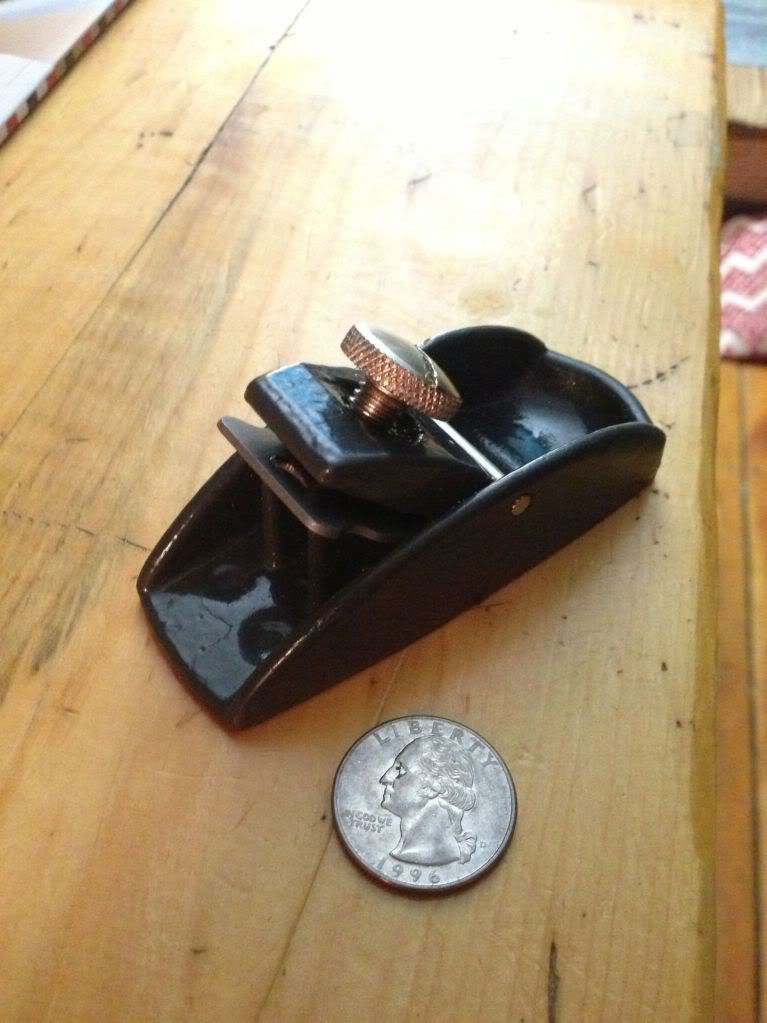 BRACES BEFORE:  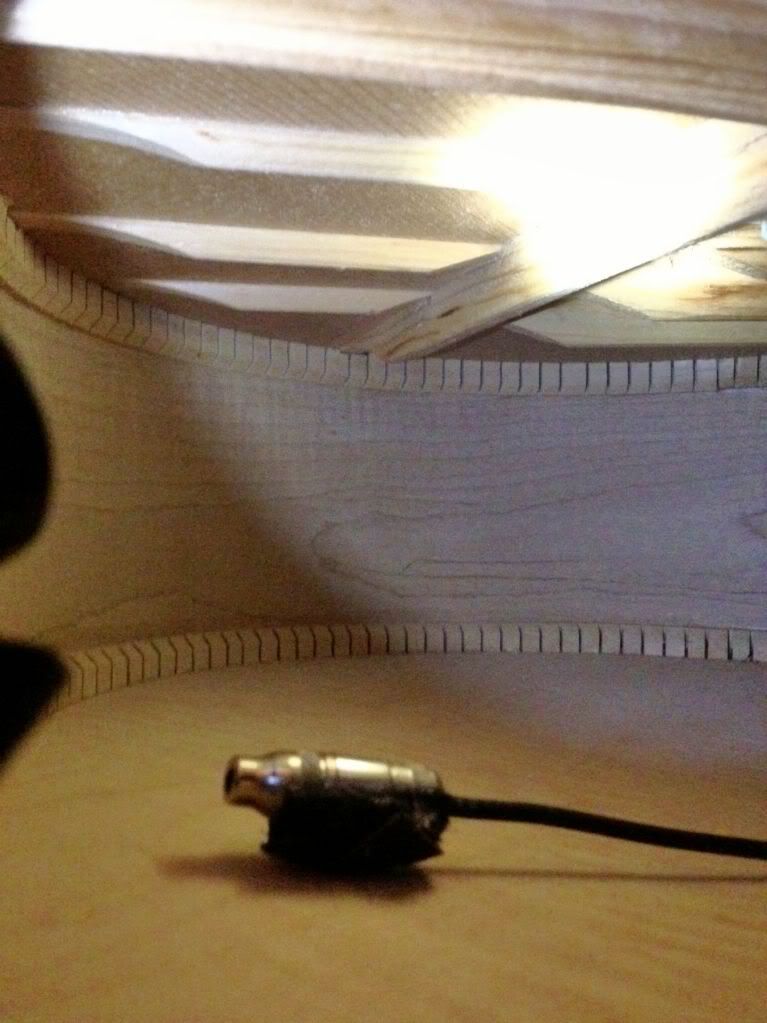 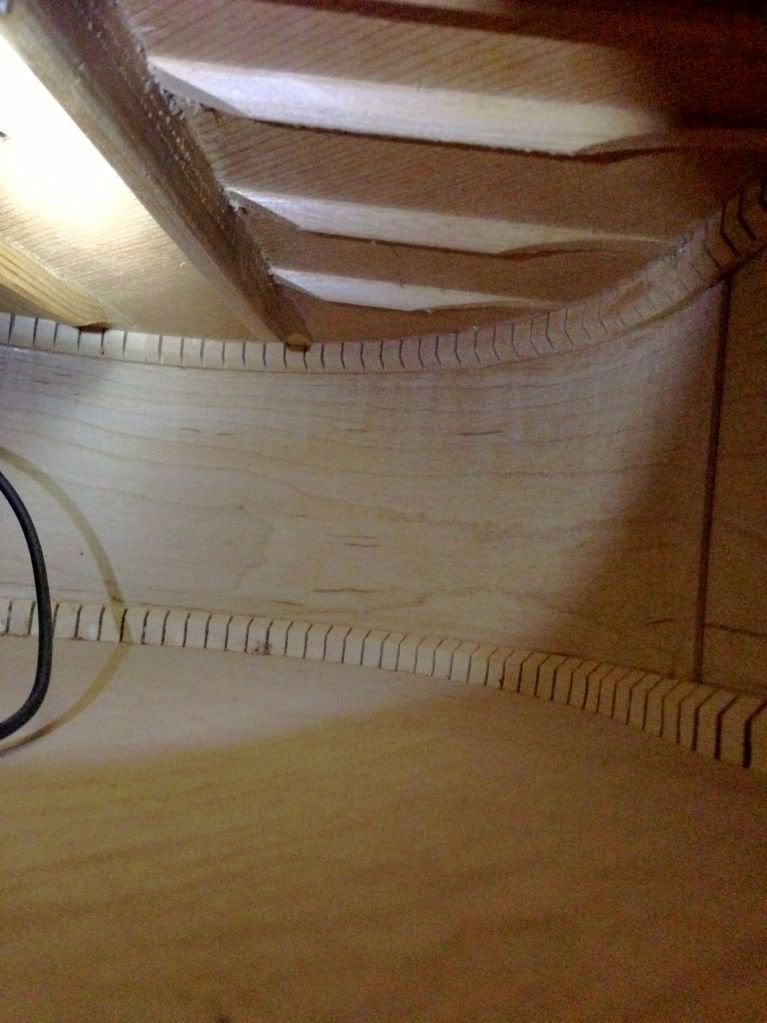 BRACES AFTER:  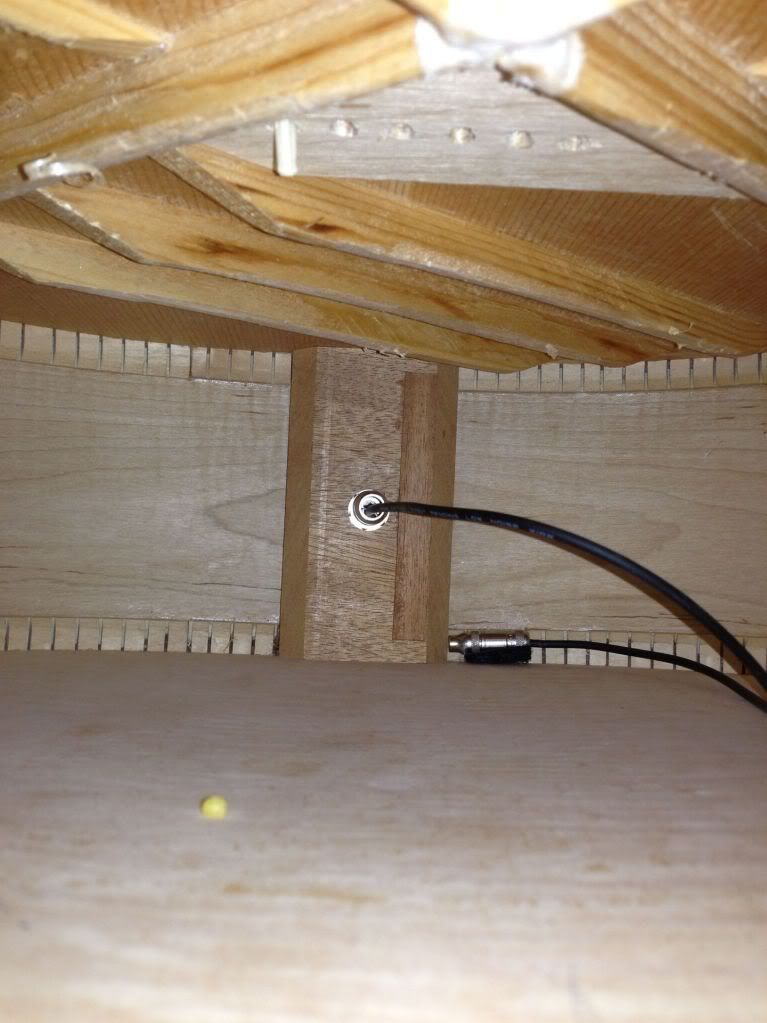 ABOUT 50% OF THE WOOD REMOVED: 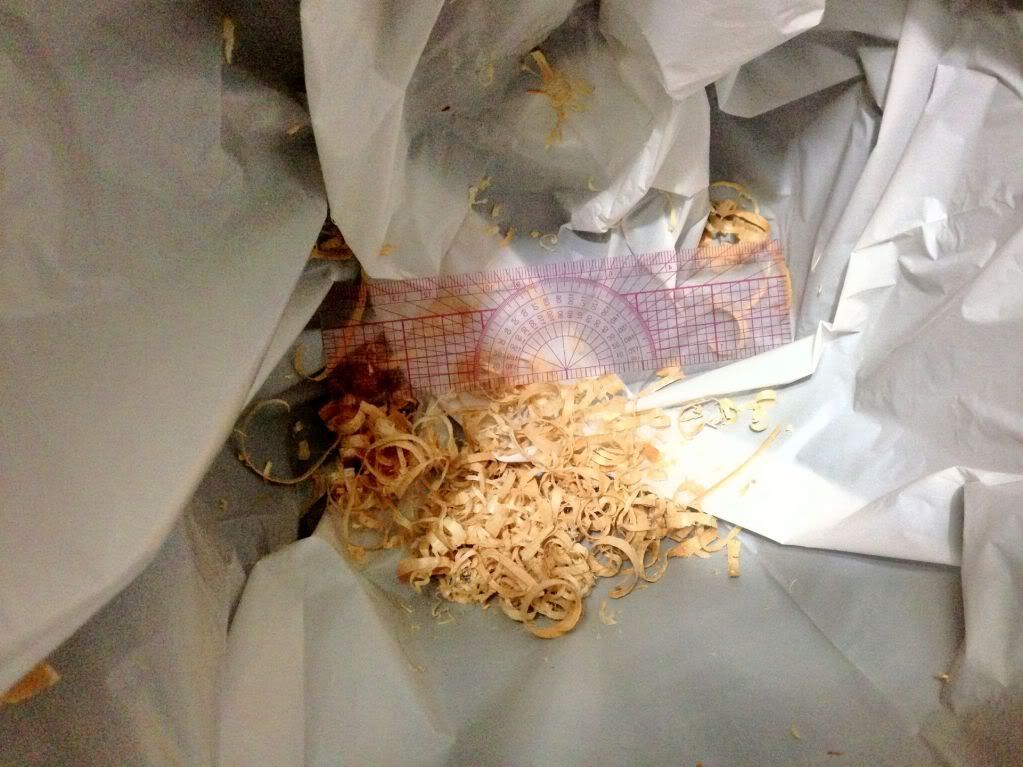
|
|
#2
|
|||
|
|||
|
Love these taboo topics.
 Stay away from the big cross brace near the neck block. Purely structural, and probably the most important brace from a structural perspective. Taking wood away from the brace sides is more about reducing mass than stiffness. Whittle away at a stick (not inside the guitar) to get a good sense of how your whittling affects strength. These braces are amazingly stiff, but reducing height can quickly reduce strength. You need stronger braces on a big top like that, but not THAT strong.  Did you consider adding 6 more tuners and making it a 12-er?
__________________
gits: good and plenty chops: snickers |
|
#3
|
|||
|
|||
|
Ok I shaved a bit more off the tone bars in the back. I think the first removal gave the biggest change. It does sound really great though (I added a walrus jawbone saddle). But I really think I can now hear the maple. Clear, fundamental.
Now, the only thing I hear that I'd like to improve, if possible, is that the low end still seems a little compressed, boxed in, restrained. I wonder if I could get it a fully open low end? I just can't really get back to those tone bars very easily. Also, I looked at new GAD JF30 12 and 6 string bracing, which are totally different (now they are fully scalloped). But regardless, none of them had 3 big tone bars! |
|
#4
|
|||
|
|||
|
Those three lower tone bars are really tone killers. At least one FEA model found that they had a huge change on the effective mass of the top -- probably a bigger damping effect than a resonance frequency effect.
__________________
gits: good and plenty chops: snickers |
|
#5
|
|||
|
|||
|
Hello Gitnoob (since you are the only one listening, hehe!) - OK, if I was more patient and had a better scientific method I'd be shaving braces in sections or something - but no! I just hack at the whole thing most times.
So I tried three more shaving experiments today. First, I decided tapered was the answer because "old school Guilds were tapered". And sadly, I dont even know if thats true (I read something...somewhere) but thats what I told myself. I think I just want excuses to experiment (Oh, an aside: I do not suggest using a dremel on the braces......just a guess because I would not be impatient enough to try such a thing....but if I did try it I'd never do it again!). The sound that came out with the "tapered" braces (tone bars still werent fully tapered) was way more balanced, with very nice middle and high string tone. But I lost the low end (duh) and did not like what I was hearing. SOunded good but not the sound I was shooting for.....most certainly did not sound like my guild. Here are some shots: 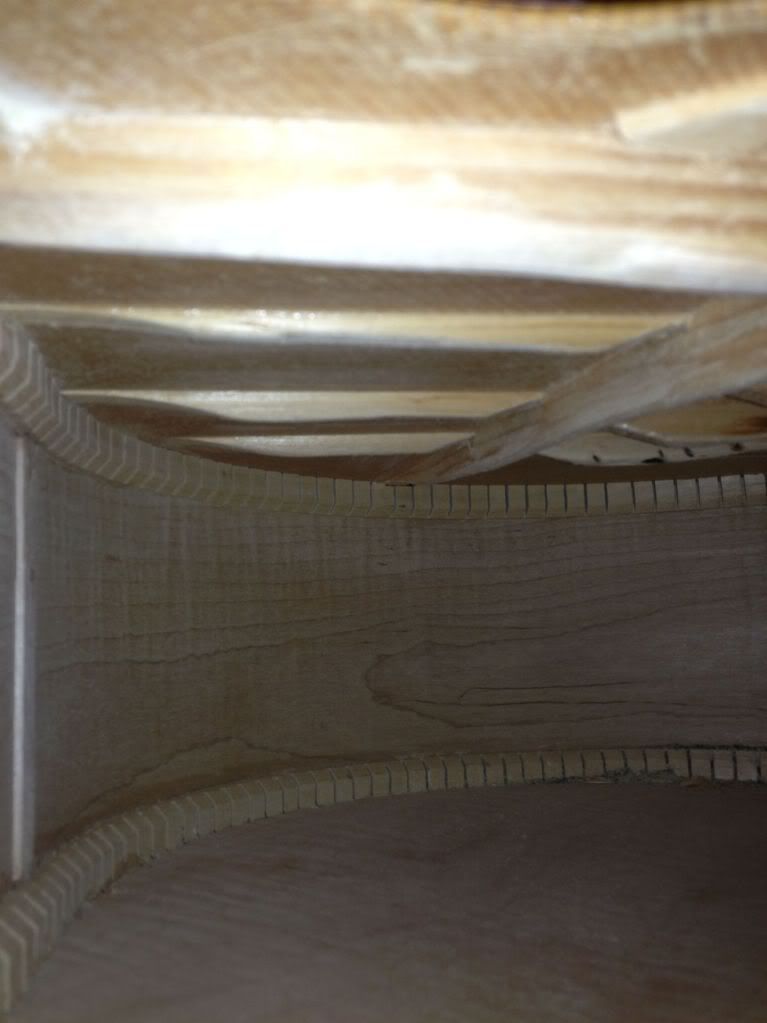 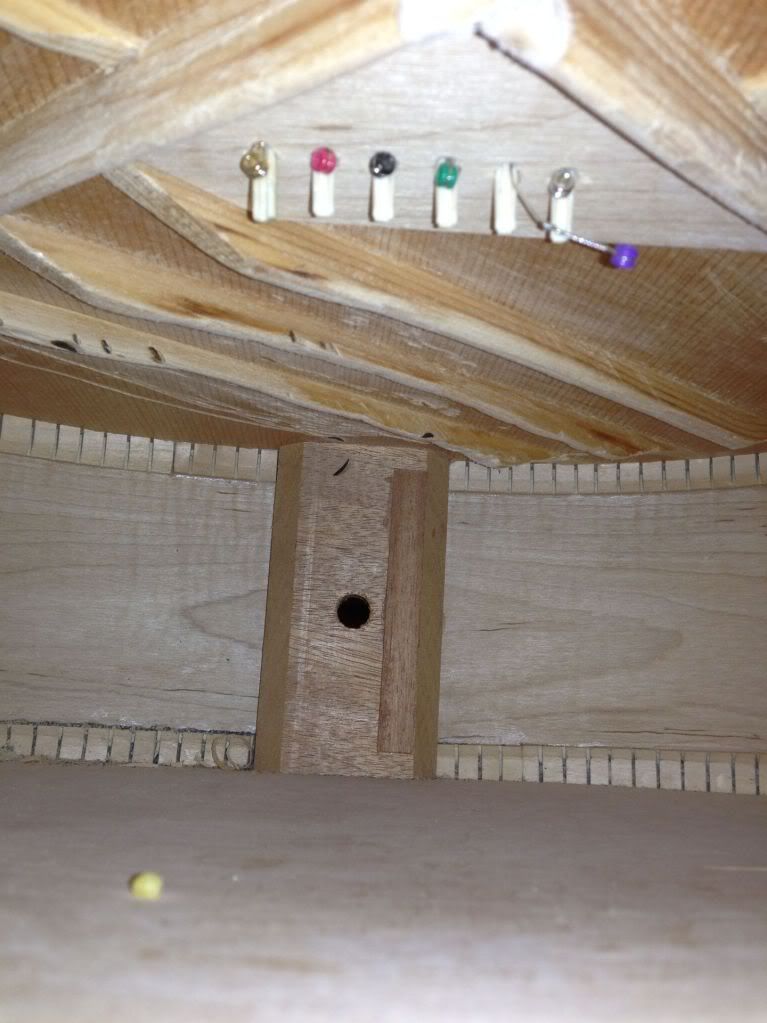 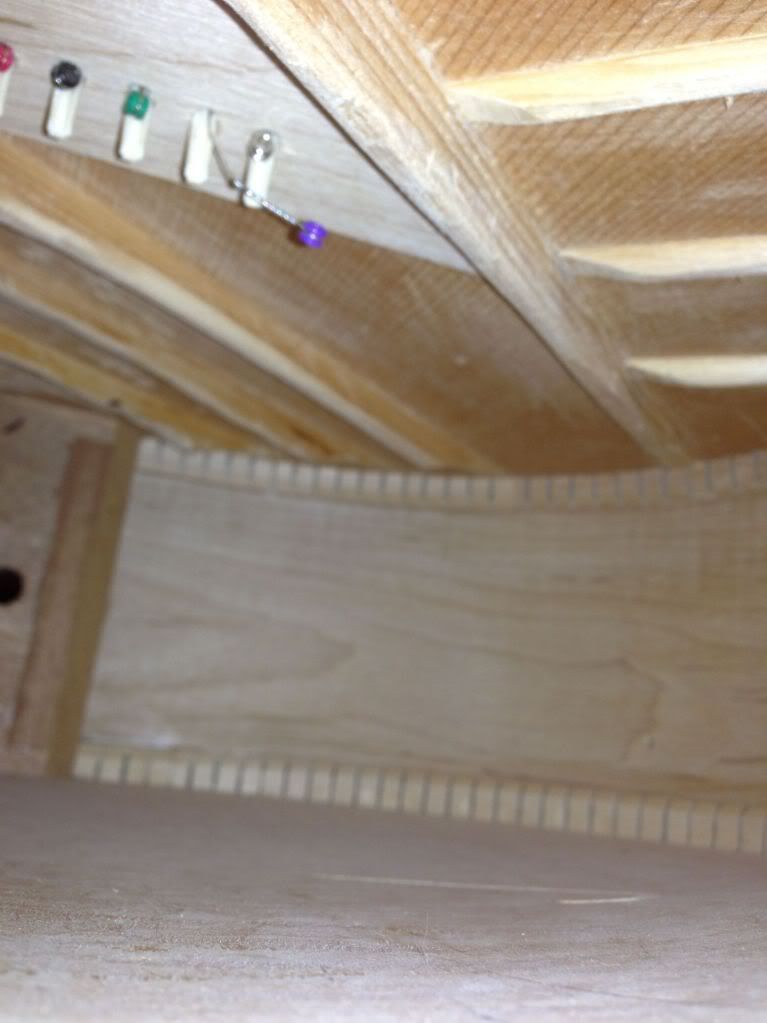 So, I decided "oh yeah, the whole point of this was to get low end and I just screwed that up" so I decided to scallop the braces a bit (I wasnt really this cavalier but I cant explain it all). This is when I got scared! I thought I went too far because it did not sound good. I dont even know exactly what the tonal problem was but the balance was way off. The lows were still not there and the highs were loud but imbalanced within themselves. Here's what the braces looked like: 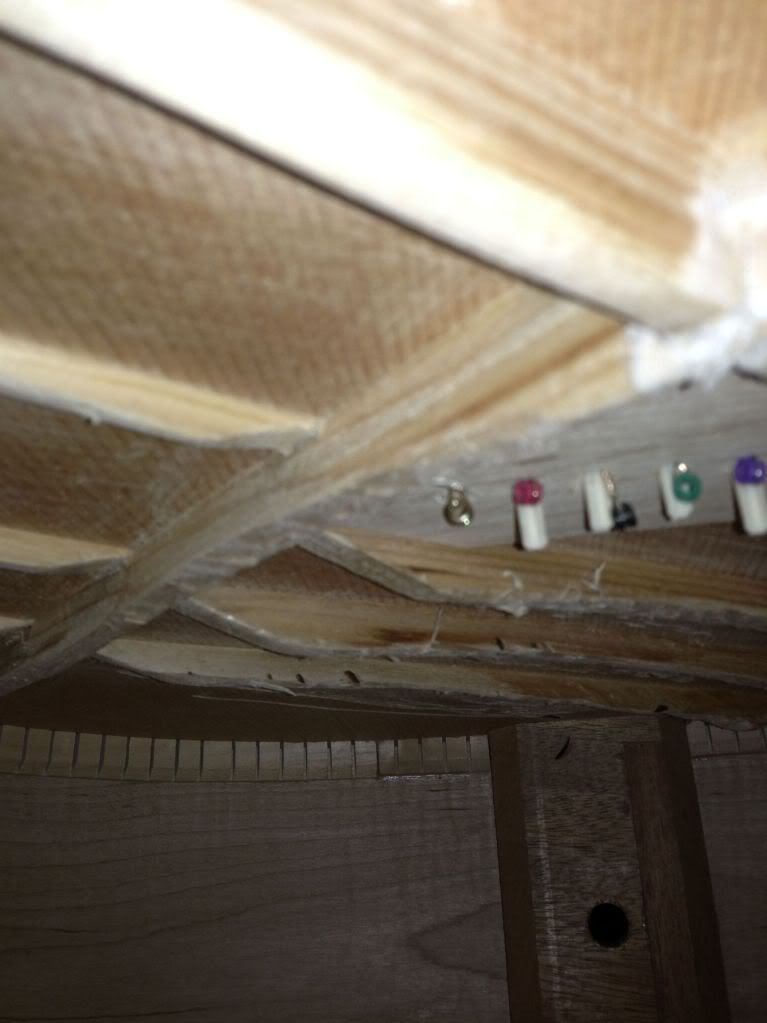 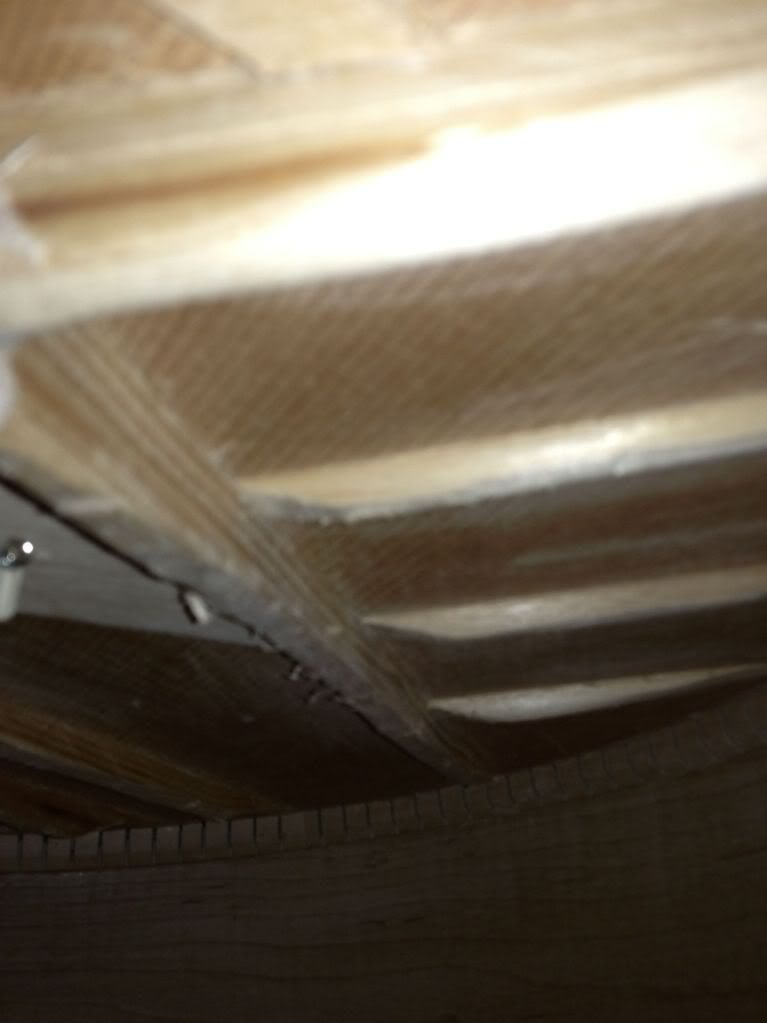 Then, I looked at a few pics of martins and gibson bracing again and decided to scallop out the low string side of the X's and tone bars. I also narrowed the front part of the X on the low string side. Ahhhh. Thank god. Sounds really good again, though a little lighter and airier but with a bigger low thump. Balance is quite good but a bit more emphasis on lows. Here's the final product: 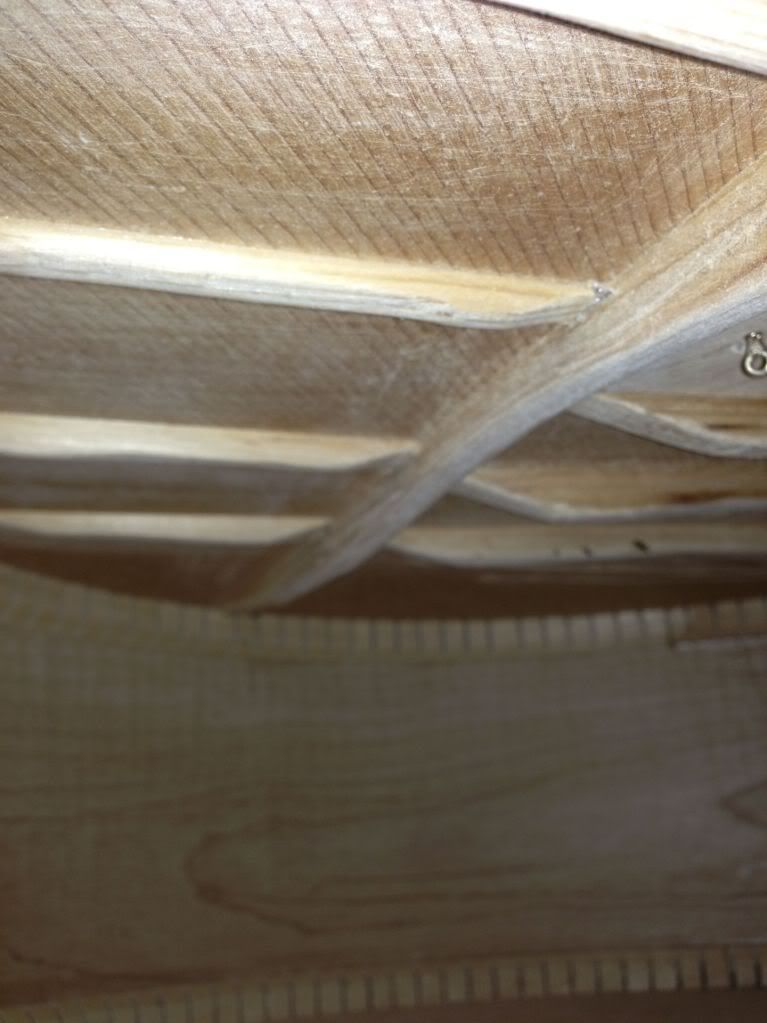 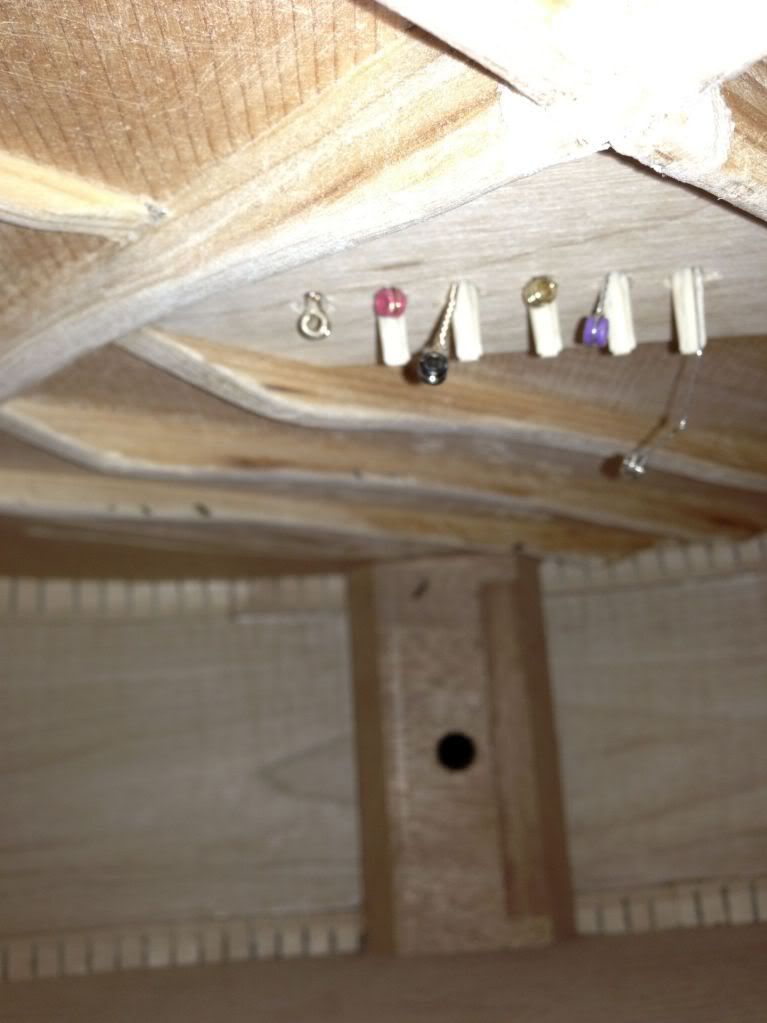 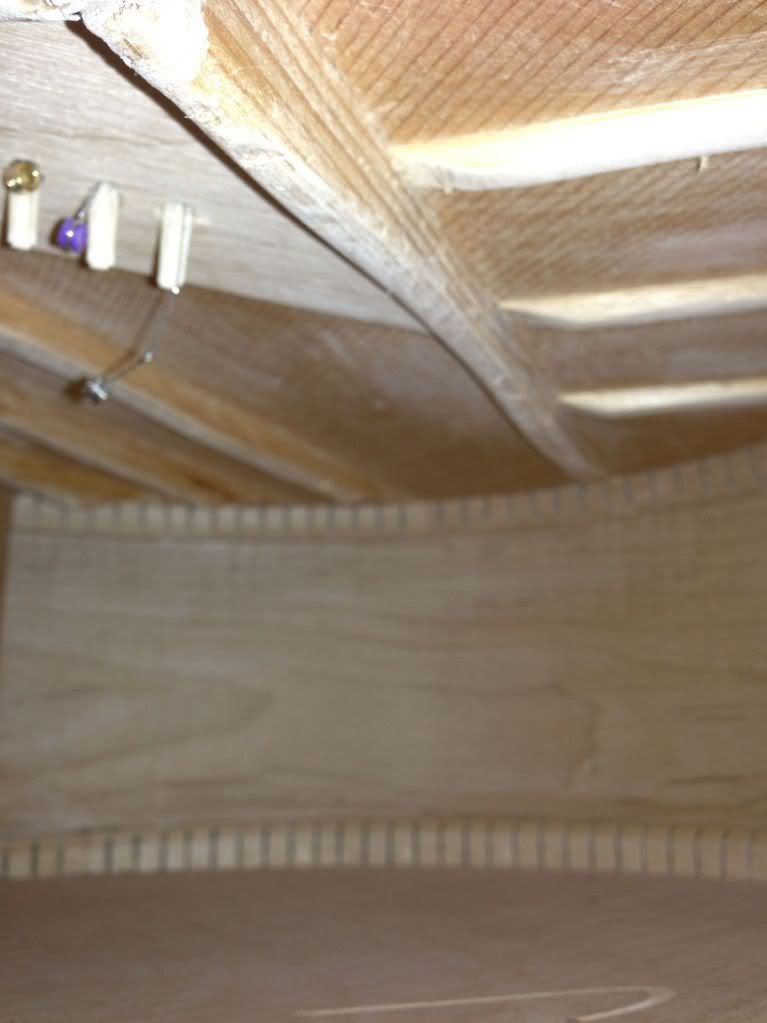 I am open to all feedback! Lemme have it but let me add one bit of info. I did this because this Guild did not sound good anymore. It once did but humidity, traveling, etc beat it down and it was unhappy. Yes, its an american made guild. But I was not going to sell it to find something I want more because this was my first decent acoustic and Im keeping it forever if I can. It loses no sentimental value for me by being modded. And I dont believe it was honed in at the factory like some would like to believe. I think they had a bunch of braces labeled "JF30" and those were thrown in there with a top, back and sides from another stack of woods labeled "JF30" and they were glued together. No tone tapping. And it probably wasnt built just for optimal sound but also longevity. OK, NOW let me have it! Thanks for those listening. Sam |
|
#6
|
|||
|
|||
|
Just reviewed last week a luthier's web site wherein he stated that the backs of guitars made in mass production are Over braced. The top bracings are also radically reduced. I'll find it again and post his site. It made a convert out of me.
I have been experimenting like you in a variety of ways in order to decide what to do with an Alvarez and Zagar Easy Play I bought that cost between them about $1200. They are not anywhere near optimum in what they can sound like. I'm doing so with a couple old Harmonys, a Framus, and no-name guitars I bought off E-bay. My first experiment, instead of going inside was to re-work the outer 'skin' of the body, to change the action, weight, and add port holes on the upper bout sides of the Harmony. I've been astonished at what this clunky things sounds like now compared to when I bought it for $75, thruout the range, bass to treble, harmonics, and hard strums. I'd likely not turn down an offer I couldn't refuse, but it would take over a thousand to pry this from my hands. No guitar I've ever had or have sounds as good, except for a May-Bell I have that I put thru the same radical wringer. I 'cut' in half the laminates that comprise the body---back, top and sides---by belt sanding the laminates down to one layer and thinning it to 3/32" or the last layer of wood, whichever comes first. These tops were built to withstand someone sitting on them accidentally. Not to produce the best tone or sound. A structural or mechanical engineer designed these things. Not a musician. A new bridge, bone nut and saddle, light Martin Strings, and no finish as yet. May only put a wash Shellac coat and be done with it. Didn't touch the neck in any way. I don't know how you did it, getting your hand inside to plane the struts, but I'm encouraged to give the back the same treatment and lighten it even more. If I can I'd like to remove one back brace entirely as well. Thanks for the risk you took and posting the results here. |
|
#7
|
|||
|
|||
|
Quote:
Quote:
The "bass" response comes from a drum-like action of the top -- the "monopole mode." So you want to enable a drum-like motion by freeing the "rim" to move like a diaphragm. You can do that with "scallops," but you end up with those high peaks near the end -- those peaks do nothing but add some mass and stiffness where you don't need it. So a "taper" is fine, but reduce the height more as your approach the rim rather than the more abrupt high-to-low transition that most associate with "taper."
__________________
gits: good and plenty chops: snickers |
|
#8
|
|||
|
|||
|
I've built over 50 guitars and I cannot make an honest opinion on the matter but I just built a little parlor guitar and this thing sounds like a dread in the bass department. Well ok maybe not that 'boom chucka' but the bass response in this little guitar is impressive. I chalk it up to having a very thin top with tapered X-brace and, in the case of the little guitar, one tapered tone brace.
I agree though that looking at those images that guitar looked way over braced. But don't mess with the forward part of the X-Brace along the sound hole through the upper bout. That is where you want to have the strength. |
|
#9
|
|||
|
|||
|
Hey all-thanks so much for the feedback.
Jack knife-excellent to hear your stories of improvement. So cool. Makes me think that if I like the aesthetics I can go for it to try to improve it (as long as its cheap). As for over bracing the back. After you said this I looked at the back bracings on entry level models at the guitar shop and yes, very huge. I don't have back braces on this laminated back. I also noticed in the new guilds that they have pretty light top bracing and they still didn't sound all that great to me. Gitnoob-yeah, I used a sanding drum on the dremel but when I saw marks in top and burning braces I thought "thank god there isn't a candid camera (smoke coming out of sound hole, hehe). I've read a bunch of the posts where you discuss your philosophy to tapered braces. But Alan carruths response/explanation of scalloping made a lot of sense too. I kind of wanted tapered as well just because all my others are scalloped. But I think I've removed enough wood now that I'm staying put. I'm seeing some minor top deformation (like slight convexity behind bridge and tiny concavity in front). Should I expect that to get worse and should I switch to light gauge? I don't want to do that cuz I like mediums. Redir-ok, no more front X shaving! Is brace shaving like gas? Ie, once you start you can't stop? Seems like it. |
|
#10
|
|||
|
|||
|
I did a few brace shavings in the 70s. The Martins of that era needed help in a lot of areas and bracing was one of them. The owners were well aware of the implications, like loss of their warranties so they went into it with eyes wide open, but I don't do them anymore. But I am lucky to be able to get my whole forearm into a dread, past my elbow and reach the ends of the x-braces, so I guess you could say I'm built for it.
Here's a tool I got back then, which I still use for shaping braces.  It started out looking like this before I cut off the ears. http://www3.towerhobbies.com/cgi-bin...P?I=LXLJ10&P=8 The beauty of this thing is that I can use my fingers to keep the blade on the brace, so doing it blind through a sound hole, it's easy to know where I'm cutting. Pat P. S. On some guitars, it would take a while, like weeks or months for the changes in sound from brace shaving to fully develop. Last edited by Pat Foster; 01-28-2013 at 06:05 PM. Reason: add a detail |
|
#11
|
|||
|
|||
|
Quote:
 It's mostly a difference in nomenclature. "Scalloped" means two things: reducing height significantly AND leaving that peak near the end. We both agree on the function of the reduced height aspect. If we differ, it might be on the usefulness of that peak near the end, although I've never actually heard anybody try to justify that peak. Seems useless to me unless it somehow impacts the higher-frequency modes. Typically, when people refer to "tapered" braces, they're referring to the non-scalloped Martin-style braces which aren't cut down as low as scalloped braces. It's the low-point (i.e., the weak point) that matters more than the shape, IMHO.
__________________
gits: good and plenty chops: snickers |
|
#12
|
|||
|
|||
|
Quote:
http://www.acousticguitarforum.com/f...d.php?t=228545 And I probZbly should not have said "makes sense" when I should have said "sounds like a very educated answer" hehe, since I don't actually fully understand it! Ok, thanks. Sam |
|
#13
|
|||
|
|||
|
What Alan is saying there is the same thing I'm saying here. Weakening the brace lowers the resonant frequency of the top -- that's how you voice for bass response.
Again, what's not discussed in that thread is the function of the peaks at the ends of the scallop.
__________________
gits: good and plenty chops: snickers |
|
#14
|
|||
|
|||
|
Quote:
So you just chopped the handles off of a spokeshave? I have one but never thought of that! So, I have two more questions if anyone has time: 1) is there a typical tonal direction newly shaved guitars go? Like "the bass really sets in after a month" or "the high end rounds out" etc or is totally an unknown? 2) by just looking at my shave job, and remembering its a lefty, does anyone have a critique of the shave job? Maybe people are afraid to offer specific advice but I'm all for it. You probZbly have to hear it eh? I really wish I would have recorded it every step of the way! Oh well. Sam |
|
#15
|
|||
|
|||
|
Quote:
"In most cases, scalloped bracing has peaks in the outer parts of the lower bout. These add a lot of stiffness in areas where ther 'cross dipole' and 'long dipole' modes are bending a lot, so those modes can end up higher in pitch. The 'cross dipole' is not a very efficient sound producer, and, in fact, seems to me to act more as a 'cutoff' for the 'main top' mode. Raising the cross dipole pitch tends to yeild a broader and taller 'main top peak in the output spectrum, which usually comes across as a more 'solid' or 'fuller' tone. The 'long dipole' is, in isolation, also not a very effective sound producer. However, it can 'couple' strongly with one of the inside air resonant modes; the 'A-1' mode. The A-1 mode is, in itself, not usually a strong sound producer either, but when it couples with the top mode you can end up with a pair of air modes, one of which can make a lot of sound at the hole. I have not done enough work with scaloped bracing to know whether the scalloped tone bars make the long dipole stiffer or looser. " |